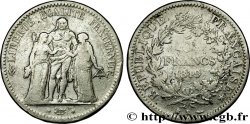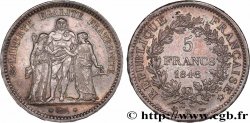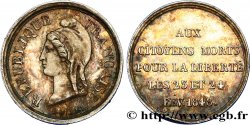Obverse
Obverse legend : RÉPUBLIQUE - FRANÇAISE.
Obverse description : Buste de la République de face, coiffée d'un bandeau où est inscrit : CONCORDE ; collier de perles et mains jointes ; signé OUDINÉ sous RÉPUBLIQUE.
Reverse
Reverse legend : (ÉPI) LIBERTÉ ÉGALITÉ FRATERNITÉ.
Reverse description : 20/ FRANCS/ 1848 en trois lignes dans une couronne formée d’une branche de chêne et d’une branche de laurier.
Historical background
II REPUBLIC
(02/24/1848-12/2/1852)
During the February 1848 revolution, Louis-Philippe abdicated in favor of his grandson, but the latter was not recognized by the Chambers and, on February 24, the Republic was proclaimed by a decree of the provisional government.. He proclaimed the freedom of work, the abolition of the death penalty in political matters, universal suffrage. The national workshops were created in March 1848. Elections are held in April and result in the success of moderate Republicans. The closing of the national workshops causes riots which are bloodily repressed by General Cavaignac who is appointed chairman of the council. The rebels are executed, imprisoned, deported. Legislative power is entrusted to a single assembly while the President of the Republic, elected by universal suffrage, holds the executive. The latter is Prince Louis Napoleon. He came into conflict with the assembly in 1850 because his re-election was unconstitutional.. Louis Napoleon then engages in the preparation of the coup d'etat which allows him, on December 2, 1851, to install his dictatorship. In November 1852, it was proposed to restore the hereditary imperial dignity. The plebiscite of November 21-22 gives nearly eight million yes for the Empire while the no collected only about 250. 000 votes. On December 2, 1852, Louis Napoleon was proclaimed emperor under the name of Napoleon III..










 Report a mistake
Report a mistake Print the page
Print the page Share my selection
Share my selection Ask a question
Ask a question Consign / sell
Consign / sell
 Full data
Full data









